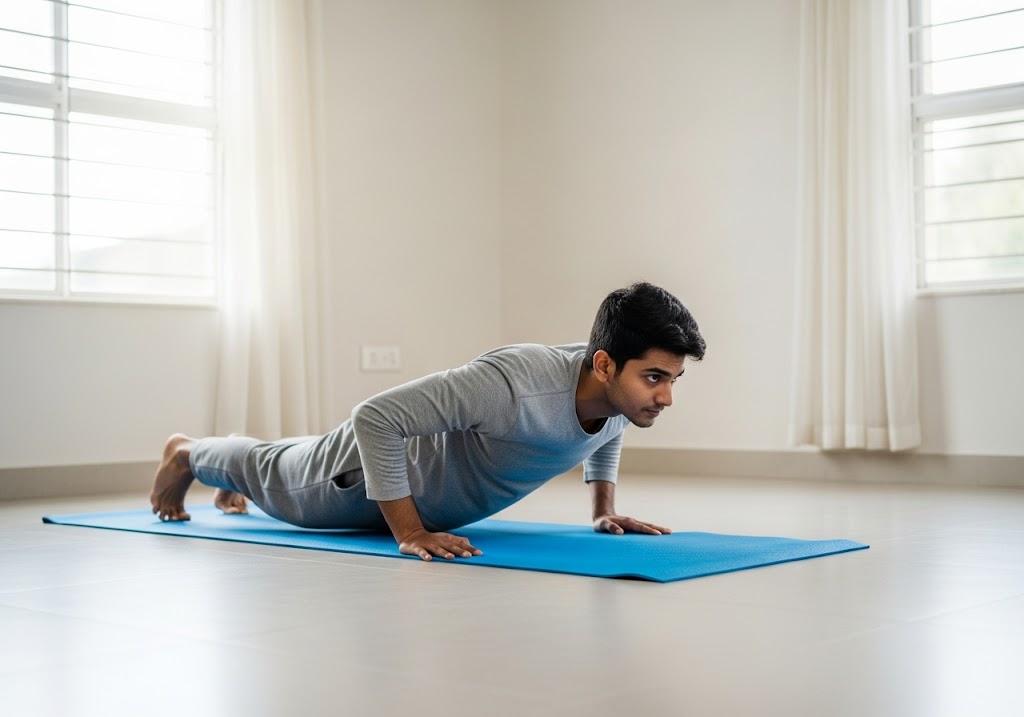Step-by-step progression to master how to do a one arm push up includes: Master regular push-ups (50+ reps), progress to archer push-ups, practice uneven push-ups, develop lever push-ups, strengthen single-arm negatives, build core stability, improve wrist strength, and gradually reduce support until achieving full one-arm push-up mastery.
Want to learn how to do a one arm push up that showcases incredible upper body strength and control? This advanced calisthenics movement represents the pinnacle of pushing strength, requiring months of dedicated training and progressive development. The one-arm push-up challenges every muscle in your upper body while demanding exceptional core stability and coordination for successful execution.
Mastering how to do a one arm push up requires understanding that this isn’t just about strength—it’s about proper progression, technique, and patience. This complete training plan covers everything from foundational strength building to advanced techniques, helping you achieve this impressive feat safely and effectively through systematic progression.
Table of Contents
What Is A One Arm Push Up?
A one-arm push-up represents the ultimate expression of upper body pushing strength and stability in bodyweight training. This advanced movement requires you to perform a complete push-up using only one arm while maintaining perfect body alignment and control throughout the entire range of motion.
The exercise demands exceptional strength from your chest, shoulders, triceps, and core muscles while challenging your body’s ability to resist rotation and maintain stability. Unlike regular push-ups where both arms share the load, learning how to do a one arm push up means one side must generate all the force while the other provides minimal assistance or none at all.
Understanding the biomechanics helps appreciate the complexity involved in mastering how to do a one arm push up effectively. Your working arm must press approximately 65-70% of your total body weight while your core prevents rotation and maintains proper spinal alignment throughout the movement.
For those starting their bodyweight training journey, bodyweight exercises for beginners provides excellent foundation exercises before attempting advanced movements like the one-arm push-up.

How to Do a One Arm Push Up? – Step-by-Step Instructions
Learning how to do a one arm push up requires following a systematic progression that builds the necessary strength, stability, and technique gradually. This step-by-step approach ensures safe development while maximizing your chances of success through proper preparation.
| Phase | Duration | Primary Focus | Key Exercises | Success Criteria |
|---|---|---|---|---|
| Foundation | Weeks 1-4 | Basic strength building | Regular push-ups, planks | 50+ consecutive push-ups |
| Intermediate | Weeks 5-12 | Unilateral development | Archer push-ups, uneven | 15+ archer push-ups/side |
| Advanced | Weeks 13-24 | Specific training | Lever push-ups, negatives | 5+ one-arm negatives/side |
| Mastery | Week 25+ | Skill refinement | Full one-arm attempts | First successful rep |
Phase 1: Foundation Building (Weeks 1-4)
Building the foundation for how to do a one arm push up starts with mastering conventional push-ups with perfect form. You should comfortably perform 50+ consecutive push-ups before progressing to more advanced variations and techniques.
Week 1-2 Focus:
- Master 3 sets of 25+ perfect push-ups with strict form
- Develop plank holds for 60+ seconds to build core stability
- Practice push-up negatives to strengthen eccentric control
- Incorporate incline push-ups to build pressing strength
Week 3-4 Progression:
- Achieve 2 sets of 40+ consecutive push-ups
- Add pause push-ups with 2-second holds at bottom position
- Include diamond push-ups for tricep strength development
- Practice single-arm planks for anti-rotation strength
Discover how many calories 15 minutes of running burns and turn your quick run into real results.
Phase 2: Intermediate Progressions (Weeks 5-12)
The intermediate phase focuses on unilateral strength development through archer push-ups and uneven push-ups. These exercises begin training one arm to handle more load while maintaining proper movement patterns essential for learning how to do a one arm push up.
Archer Push-Up Development:
- Start with wide hand position and shift weight to one side
- Lower down while straightening the non-working arm
- Press up primarily with the working arm
- Perform 3 sets of 8-12 repetitions each side
Uneven Push-Up Progression:
- Place one hand on elevated surface (basketball, book)
- Perform push-ups with majority of weight on lower hand
- Gradually increase elevation height over time
- Progress to 3 sets of 10-15 repetitions each side
Phase 3: Advanced Training (Weeks 13-24)
Advanced training for how to do a one arm push up involves lever push-ups and negative training that directly prepare you for the full movement. This phase requires patience and consistent practice to develop the specific strength patterns needed.
Lever Push-Up Technique:
- Position working arm under chest center
- Extend non-working arm out to side for balance
- Lower and press with strict control
- Build to 3 sets of 6-10 repetitions each side
One-Arm Push-Up Negatives:
- Start in top position of one-arm push-up
- Lower down slowly over 5-10 seconds
- Use other arm minimally for return to top
- Practice 3 sets of 3-5 negatives each side
For developing the core strength essential for one-arm push-ups, how to do plank exercise provides fundamental stability training techniques.

Benefits of the One-Arm Push-Up
The benefits of mastering how to do a one arm push up extend far beyond impressive demonstrations of strength. This movement develops functional power, improves muscle imbalances, and builds the kind of real-world strength that transfers to daily activities and athletic performance.
- Unilateral Strength Development: Building strength independently on each side prevents imbalances and ensures balanced muscle development
- Core Stability Enhancement: Anti-rotation demands strengthen deep stabilizing muscles more than bilateral exercises
- Improved Neuromuscular Control: Complex coordination requirements enhance mind-muscle connection and movement quality
- Functional Strength Building: Single-arm strength translates to real-world activities requiring one-arm pushing or pressing
- Mental Toughness Development: Achieving this challenging goal builds confidence and mental resilience for other challenges
- Superior Muscle Activation: Higher muscle recruitment compared to regular push-ups creates better strength and size gains
The progression toward learning how to do a one arm push up also improves your regular push-up performance significantly. The strength and stability gained transfer to all pressing movements, making you stronger in conventional exercises as well.
For comprehensive calisthenics training that complements one-arm push-up development, calisthenics exercises provides a complete exercise library for advanced bodyweight training.
Tips for Doing One-Arm Push-Ups
Success in learning how to do a one arm push up depends on following specific technique tips and avoiding common mistakes that prevent progress. These practical strategies accelerate your development while ensuring proper form and injury prevention throughout your training journey.
- Wide Foot Stance: Spread feet 1.5-2 times shoulder width for maximum stability base during the movement
- Central Hand Placement: Keep working arm directly under chest center for optimal leverage and force production
- Core Engagement: Maintain tight core throughout entire movement to prevent hip rotation and sagging
- Controlled Tempo: Lower slowly over 3-4 seconds, pause briefly, then press up with explosive power
- Proper Breathing: Inhale at top, hold breath during descent, exhale forcefully during pressing phase
- Progressive Loading: Master each progression thoroughly before advancing to more difficult variations
- Wrist Preparation: Strengthen wrists through specific exercises to handle the intense single-arm loading
- Mental Rehearsal: Visualize perfect technique regularly to reinforce proper movement patterns
- Consistent Practice: Train 5-6 days weekly with varying intensities for optimal skill development
- Patience Focus: Accept that mastery requires months or years of dedicated, systematic training
For comprehensive training programs that support advanced movements, full body calisthenics workout provides complete routines for serious calisthenics athletes.

Maximize Your Upper-Body Gains With a Push Day Workout
Maximizing upper-body gains while training for how to do a one arm push up requires strategic workout planning that balances pushing strength development with proper recovery. A well-designed push day workout accelerates your progression while building the comprehensive strength needed for advanced calisthenics movements.
Push day workouts should emphasize progressive overload through increased repetitions, advanced variations, or decreased rest periods. The key is maintaining consistent challenge while allowing adequate recovery between sessions to promote strength adaptation and muscle growth for one-arm push-up development.
| Exercise | Sets | Reps | Rest | Purpose |
|---|---|---|---|---|
| Regular Push-ups | 4 | Max reps | 90s | Foundation building |
| Archer Push-ups | 3 | 8-12/side | 120s | Unilateral strength |
| Pike Push-ups | 3 | 10-15 | 90s | Shoulder development |
| Diamond Push-ups | 3 | 12-20 | 90s | Tricep strength |
| Single-Arm Negatives | 3 | 3-5/side | 180s | Specific training |
| Plank Hold | 3 | 60+ seconds | 60s | Core stability |
The workout structure should progress from general strength building to specific one-arm push-up preparation as your training advances. Begin each session with proper warm-up and conclude with stretching to maintain mobility and prevent injury throughout your development process.
How Many Push Ups Per Day for Big Chest?
Building a big chest through daily push-ups requires strategic volume and variation rather than simply performing massive numbers of repetitions. The optimal approach combines different push-up variations with adequate recovery to stimulate muscle growth while progressing toward advanced movements like learning how to do a one arm push up.
For chest development, focus on 150-300 total push-ups daily spread across multiple sets and variations. This volume provides sufficient stimulus for muscle growth while maintaining form quality and allowing progression toward more challenging variations that support one-arm push-up development goals.
| Experience Level | Daily Volume | Set Structure | Variations | Weekly Frequency |
|---|---|---|---|---|
| Beginner | 50-100 push-ups | 5 sets of 10-20 | Standard, incline | 5-6 days |
| Intermediate | 100-200 push-ups | 6 sets of 15-35 | Wide, diamond, archer | 6 days |
| Advanced | 200-300 push-ups | 8 sets of 25-40 | Decline, one-arm prep | Daily |
Quality always trumps quantity when building chest muscle through push-ups. Focus on perfect form, full range of motion, and progressive difficulty rather than chasing high numbers with compromised technique that won’t contribute to your one-arm push-up goals.
For understanding the relationship between different training approaches, calisthenics vs gym explores the benefits of bodyweight training versus traditional weight lifting.
How Many Push Ups Per Day for Beginners?
Beginners should start with 20-50 push-ups daily, focusing on perfect form and gradual progression rather than high volume. This conservative approach builds strength safely while establishing proper movement patterns that serve as the foundation for eventually learning how to do a one arm push up.
The progression should emphasize consistency and technique development over aggressive volume increases. Start with 3 sets of 5-10 push-ups and increase by 2-3 repetitions weekly, allowing your muscles and joints to adapt gradually to the training stimulus and movement demands.
Beginner Push-Up Progression Schedule
Week 1-2: Master the basic movement pattern with modified push-ups if necessary, focusing on maintaining straight body alignment and full range of motion throughout each repetition.
Daily Structure:
- 3 sets of 5-8 push-ups with 60-90 seconds rest
- Focus on 3-second descent, 1-second pause, 2-second ascent
- Perform on knees if full push-ups are too challenging
- Maintain daily consistency rather than high intensity
Week 3-4: Increase volume gradually while maintaining perfect form, adding 1-2 repetitions per set weekly to ensure consistent progress without overwhelming your developing strength and coordination.
Progression Guidelines:
- Increase to 3 sets of 8-12 push-ups
- Transition from knee to full push-ups if ready
- Add incline variations for additional challenge
- Monitor recovery and adjust volume accordingly
For beginners seeking comprehensive training guidance, basic calisthenics workout provides structured progressions for safe strength development.
How Many Push Ups Per Day to Lose Belly Fat?
Push-ups alone won’t directly target belly fat loss, but they contribute to overall calorie expenditure and muscle building that supports fat loss goals. The key lies in creating a calorie deficit through combined diet and exercise strategies.
| Daily Volume | Calories Burned | Training Style | Additional Benefits | Fat Loss Support |
|---|---|---|---|---|
| 100-150 push-ups | 50-75 calories | Circuit style | Muscle building | Moderate support |
| 150-200 push-ups | 75-100 calories | High intensity | Metabolic boost | Good support |
| 200+ push-ups | 100+ calories | Mixed variations | Maximum muscle mass | Strong support |
The metabolic benefits of learning how to do a one arm push up extend beyond the exercise itself, as the training process builds significant muscle mass and burns calories throughout your development journey. Combine push-up training with proper nutrition for optimal belly fat reduction results.
For additional calorie-burning exercises that complement push-up training, cycling for 30 minutes burns how many calories provides information about cardiovascular training that supports fat loss goals.

How Many Wall Push Ups Per Day?
Wall push-ups serve as an excellent starting point for those building toward regular push-ups and eventually learning how to do a one arm push up. These low-impact movements provide accessible strength building for beginners, rehabilitation patients, and those new to exercise.
| Experience Level | Daily Volume | Weekly Progression | Set Structure | Transition Goal |
|---|---|---|---|---|
| Complete Beginner | 30-50 reps | Add 5-10 reps weekly | 3 sets of 10-15 | Move feet further back |
| Building Strength | 60-100 reps | Add difficulty angle | 4 sets of 15-25 | Progress to incline |
| Pre-Regular | 100+ reps | Reduce wall angle | 5 sets of 20+ | Transition to knee push-ups |
Wall push-ups provide the perfect foundation for building the pushing strength that eventually supports learning how to do a one arm push up through proper progression and consistent practice. Focus on perfect form and gradual progression rather than high repetition counts.
How Many Push Up Per Day?
The optimal number of daily push-ups depends on your fitness level, goals, and recovery capacity. General recommendations range from 50-300 push-ups daily, with beginners starting at the lower end and advanced practitioners working toward higher volumes while maintaining quality over quantity principles.
For general fitness maintenance, 50-100 daily push-ups provide excellent benefits for upper body strength and endurance. Those working toward advanced goals like learning how to do a one arm push up may need 200-300 daily repetitions across various progressions and intensity levels for optimal development.
Daily Push-Up Guidelines by Goal:
| Goal | Daily Volume | Intensity | Variations | Rest Days |
|---|---|---|---|---|
| General Fitness | 50-100 | Moderate | 2-3 types | 1-2 weekly |
| Strength Building | 100-200 | High | 4-5 types | 1 weekly |
| Advanced Skills | 200-300 | Very High | 6+ types | Recovery focus |
| Fat Loss | 150-250 | Circuit style | 3-4 types | Active recovery |
Quality remains more important than quantity in all push-up training. Focus on perfect form, progressive difficulty, and consistent practice rather than chasing arbitrary numbers that may compromise your technique or recovery between sessions.
For understanding recovery needs during intensive training, should you exercise with sore muscles provides guidance on training through muscle fatigue safely.
How Many Push Ups Per Day to Build Chest?
Building chest muscle through daily push-ups requires strategic volume and variation rather than endless repetitions. The key lies in progressive overload through increased difficulty rather than just higher repetition counts, especially when working toward learning how to do a one arm push up.
| Experience Level | Daily Volume | Variation Distribution | Weekly Focus | Expected Results |
|---|---|---|---|---|
| Beginner | 75-150 reps | 70% standard, 30% variations | Form + endurance | Noticeable growth 4-6 weeks |
| Intermediate | 150-225 reps | 50% standard, 50% variations | Strength + size | Visible definition 6-8 weeks |
| Advanced | 225-300 reps | 30% standard, 70% advanced | Power + skill prep | One-arm progression ready |
The progression toward how to do a one arm push up naturally builds exceptional chest development through the demanding unilateral strength requirements and stabilization challenges inherent in the movement. Focus on quality over quantity for optimal chest building results.
Russian Push-Up and Advanced Variations
The Russian push-up represents an intermediate progression toward learning how to do a one arm push up, involving shifting weight from side to side during the movement. This variation builds unilateral strength while teaching weight transfer skills essential for one-arm push-up development.
Russian push-ups bridge the gap between standard push-ups and archer push-ups in the progression toward one-arm mastery. The side-to-side movement pattern teaches your body to handle uneven loading while maintaining stability and control throughout the challenging range of motion.
Russian Push-Up Technique
Setup and Execution:
- Begin in standard push-up position
- Lower down while shifting weight to one arm
- Press up and shift weight to opposite arm
- Continue alternating sides throughout set
- Maintain core stability during weight transfers
Progression to One-Arm:
- Increase weight shift duration on each side
- Reduce assistance from non-working arm gradually
- Practice holding positions at various ranges
- Build to 15+ repetitions before advancing
The Russian push-up develops the coordination and strength patterns directly applicable to how to do a one arm push up while providing a challenging workout that builds impressive upper body strength and control.
For advanced calisthenics movements that complement push-up training, calisthenics planche provides information about another challenging upper body skill requiring exceptional strength and balance.
Hindu Push-Up Progression
Hindu push-ups provide dynamic strength development that complements static one-arm push-up training through their flowing movement pattern and comprehensive muscle activation. This traditional exercise builds flexibility, strength, and endurance while preparing your body for the demands of learning how to do a one arm push up.
The flowing nature of Hindu push-ups improves shoulder mobility and strengthens the entire kinetic chain involved in pushing movements. This enhanced mobility and dynamic strength transfer directly to improved one-arm push-up performance and injury prevention throughout your training progression.
Basic Hindu Push-Up Technique:
- Start in downward dog position
- Lower chest toward ground in diving motion
- Press up while arching back into upward dog
- Return to starting position with controlled flow
- Maintain continuous movement throughout set
Integration with One-Arm Training:
- Use as warm-up before specific training
- Include in recovery sessions for active rest
- Build to 20+ consecutive repetitions
- Focus on smooth, controlled movement quality
Hindu push-ups enhance the shoulder stability and core strength essential for mastering how to do a one arm push up while providing variety that prevents training monotony and overuse injuries.
Training Frequency and Recovery
Optimal training frequency for learning how to do a one arm push up requires balancing intense skill practice with adequate recovery for strength adaptation. Most practitioners benefit from training 5-6 days weekly with varying intensities and focus areas to promote consistent progress while preventing overuse injuries.
The demanding nature of one-arm push-up training requires strategic recovery planning to allow strength gains and prevent burnout. Include easy days focused on mobility and technique alongside intense days emphasizing maximum strength development for balanced progression throughout your development journey.
Weekly Training Structure:
- Monday/Friday: High intensity one-arm progressions
- Tuesday/Thursday: Moderate volume foundation work
- Wednesday/Saturday: Technique and mobility focus
- Sunday: Complete rest or light movement
Recovery indicators include strength progression, movement quality, and absence of persistent fatigue or joint discomfort. Adjust training intensity and frequency based on your individual recovery capacity and progression rate toward mastering how to do a one arm push up.
For optimal training timing and recovery strategies, is it better to do cardio before or after weights provides guidance on exercise sequencing for maximum results.
Nutrition Support for One-Arm Push-Up Training
Proper nutrition supports the intense training demands of learning how to do a one arm push up through adequate protein for muscle repair, carbohydrates for energy, and overall calorie balance for strength development. Focus on whole foods that provide sustained energy and support recovery between challenging training sessions.
Protein requirements increase during intensive strength training, with 1.6-2.2 grams per kilogram of body weight supporting optimal muscle protein synthesis and recovery. Time protein intake around training sessions to maximize adaptation and support the muscle building necessary for one-arm push-up strength development.
Nutritional Priorities
Daily Nutrition Targets:
- Protein: 1.8-2.2g per kg body weight
- Carbohydrates: 5-7g per kg for training fuel
- Fats: 1g per kg for hormone production
- Water: 35ml per kg plus exercise needs
Pre-Training Nutrition:
- Light meal 2-3 hours before training
- Focus on easily digestible carbohydrates
- Include moderate protein for muscle protection
- Maintain adequate hydration status
Post-Training Recovery:
- Protein and carbohydrate combination within 2 hours
- Emphasize complete protein sources
- Include anti-inflammatory foods
- Prioritize sleep quality for recovery
For comprehensive nutrition guidance that supports intensive training, calisthenics diet chart provides specific meal planning for calisthenics athletes.

Common Mistakes and How to Avoid Them
Learning how to do a one arm push up involves avoiding common mistakes that prevent progress and increase injury risk. The most frequent errors include rushing progression, neglecting proper form, and inadequate preparation through foundation strength building exercises and mobility development.
- Rushing Progression: Attempting advanced variations too early leads to injury and plateau – master each step thoroughly before advancing
- Poor Body Alignment: Allowing hips to sag or rotate reduces effectiveness and increases injury risk during attempts
- Inadequate Foundation: Skipping basic strength requirements prevents success – build to 50+ regular push-ups first
- Using Momentum: Bouncing or explosive movements reduce strength building and proper technique development
- Neglecting Core Work: Insufficient core stability prevents proper body control during one-arm attempts
- Inconsistent Hand Position: Placing working hand incorrectly reduces leverage and increases difficulty unnecessarily
- Ignoring Recovery: Training too frequently without rest prevents strength adaptation and increases overuse injury risk
- Unrealistic Timelines: Expecting quick results leads to frustration and poor training decisions
- Neglecting Weak Side: Only training dominant arm creates imbalances and limits overall development
- Poor Warm-up: Inadequate preparation increases injury risk during high-intensity training sessions
Success in learning how to do a one arm push up comes from methodical progression, consistent practice, and attention to detail throughout the lengthy development process.
Mental Preparation and Goal Setting
The mental aspect of learning how to do a one arm push up requires setting realistic timelines, celebrating small victories, and maintaining motivation through inevitable plateaus. Visualization techniques enhance training effectiveness by mentally rehearsing the movement pattern and building confidence.
| Goal Timeline | Milestone Targets | Mental Strategies | Success Indicators | Motivation Techniques |
|---|---|---|---|---|
| Months 1-3 | 50+ regular push-ups, plank mastery | Daily visualization | Consistent form improvement | Celebrate weekly gains |
| Months 3-6 | Archer push-ups, unilateral strength | Progress tracking | Movement quality increase | Document video progress |
| Months 6-12 | Lever push-ups, negatives | Patience mindset | Specific skill development | Focus on process goals |
| Year 1+ | First one-arm rep | Persistence focus | Achievement unlocked | Share accomplishment |
The journey of learning how to do a one arm push up teaches patience, persistence, and systematic progression that transfers to other challenging goals in fitness and life. Most people require 6-24 months of consistent training depending on starting strength and dedication level.
For additional bodyweight challenges that complement one-arm push-up training, unilateral exercises provides comprehensive single-limb training options for balanced development.
Recovery Strategies and Injury Prevention
Intensive one-arm push-up training demands strategic recovery protocols to prevent overuse injuries and support continued progress. Include mobility work, adequate sleep, and active recovery methods to maintain training consistency while building toward mastering how to do a one arm push up.
Wrist and shoulder health require particular attention during one-arm push-up training due to the high forces and asymmetrical loading patterns involved. Incorporate specific mobility exercises, strengthening protocols, and recovery modalities to maintain joint health throughout your training progression.
Recovery Protocol Implementation
Daily Recovery Habits:
- 7-9 hours quality sleep for muscle repair
- Morning mobility routine for joint preparation
- Post-training stretching for muscle length
- Adequate hydration throughout the day
Weekly Recovery Planning:
- Schedule complete rest days for system recovery
- Include active recovery with light movement
- Address tight areas with targeted stretching
- Monitor training load and adjust accordingly
Injury Prevention Strategies:
- Proper warm-up before intensive training
- Progressive loading to avoid overuse
- Address imbalances through corrective exercises
- Listen to body signals and modify training
Recovery quality often determines training progression speed more than training intensity when learning how to do a one arm push up, making it a critical component of your development plan.
Understanding recovery techniques such as what is foam rolling can significantly enhance your training recovery and reduce injury risk during intensive skill development.
Conclusion
Learning how to do a one arm push up represents one of the most challenging and rewarding goals in bodyweight training. Success requires patience, systematic progression, and consistent practice over months or years of dedicated training. The journey builds exceptional upper body strength, core stability, and mental toughness that extends far beyond the exercise itself. Remember that mastering how to do a one arm push up is about the process as much as the destination. Each progression step builds valuable strength and skills while teaching important lessons about goal setting, persistence, and systematic improvement that apply to all areas of life and fitness development.
Want to master the calisthenics handstand and take your skills to the next level? Whether you’re a beginner or pushing advanced skills, ISC – Indian School of Calisthenics offers expert guidance to help you master bodyweight training. Visit us at SRPF Ground, NH8, Goregaon (E), Mumbai – 400065. For class schedules, personalized coaching, or more details, call +91 77159 53218. Train smart, move better, and unlock your back strength with ISC.
How to Do a One Arm Push Up? – FAQs
How to learn to do a one arm push up?
Start with mastering 50+ regular push-ups, progress through archer push-ups and uneven variations, then practice one-arm negatives before attempting the full movement.
How to train for one arm push up?
Follow systematic progression from regular push-ups to archer push-ups, uneven push-ups, lever push-ups, and finally one-arm negatives over 6-24 months.
How to work up to a 1 arm push-up?
Build foundation strength with 50+ push-ups, develop unilateral strength through progressions, and practice specific one-arm movement patterns consistently.
Are 1 arm pushups effective?
Yes, one-arm push-ups are extremely effective for building unilateral strength, core stability, and impressive upper body muscle development.
What’s the hardest push-up?
The one-arm push-up is among the most difficult push-up variations, requiring exceptional strength, stability, and months of progressive training.
What is Russian push-up?
Russian push-ups involve shifting weight side-to-side during the movement, serving as an intermediate progression toward one-arm push-ups.
How to 90 degree push-up?
The 90-degree push-up (planche push-up) requires advanced planche strength and is more challenging than one-arm push-ups for most people.
What is the world record for one-arm push-ups?
Various records exist for one-arm push-ups, with some athletes performing 100+ consecutive repetitions, though records vary by organization and criteria.
How to get a 1 arm pull up?
One-arm pull-ups require different training than push-ups, focusing on weighted pull-ups, archer pull-ups, and assisted one-arm negatives.
How to do a perfect push-up?
Maintain straight body line, lower chest to ground, press up with control, and keep core tight throughout the entire movement.


